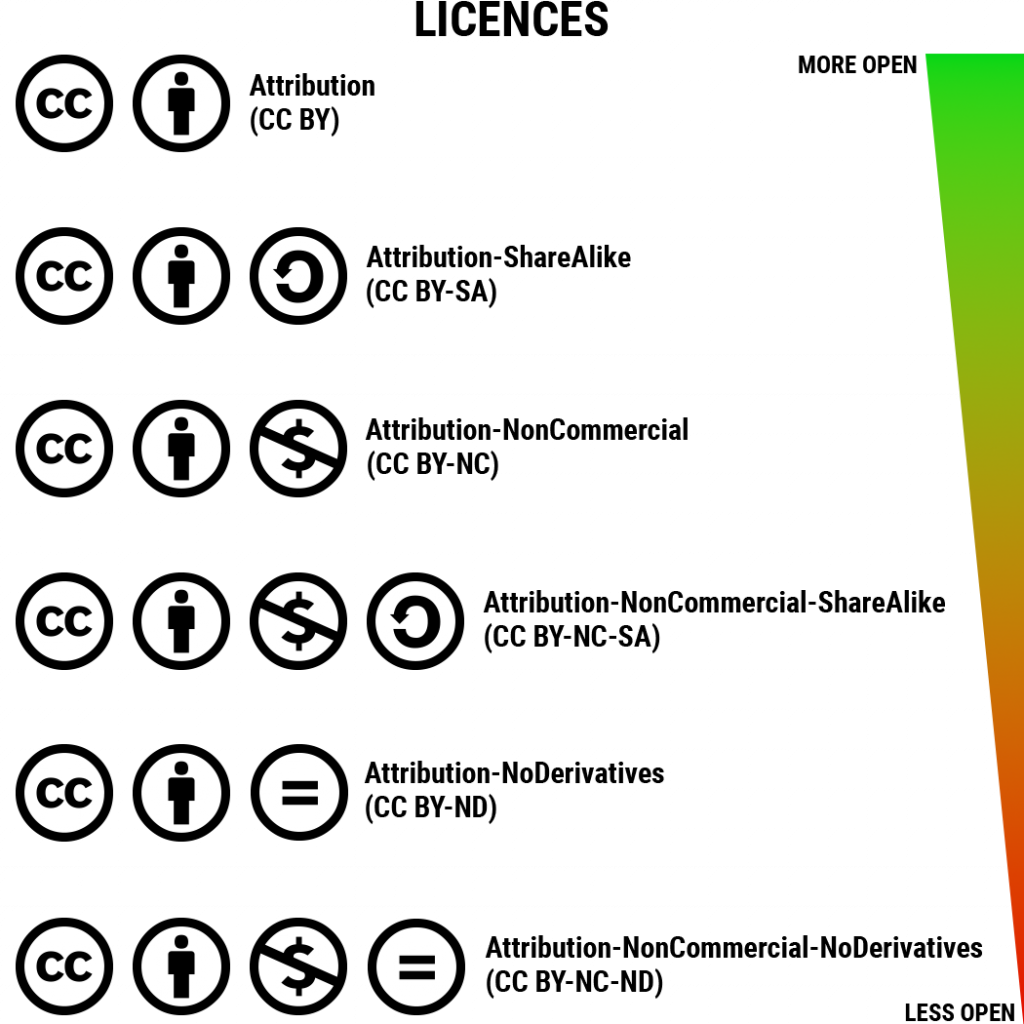Creative Commons licences provide a standardised way for copyright owners to grant permission to reuse their creative work. There are four elements in the CC system.

There elments can be combined to form six different licences, shown here in order of least to most restrictive.

The Creative Commons website has a more detailed description of each of the CC licences and the uses they permit. Below is a summary of each licence and the two badges CC makes available to represent each of them.

- Attribution (CC BY): The Attribution licence allows others to copy, distribute and remix the material in any medium or format, even commercially, as long as the creator is attributed. Sometimes called the Attribution Only licence, this licence option is the most open of the CC licences.

- Attribution-ShareAlike (CC BY-SA): This license others to copy, distribute and remix the material in any medium or format, even commercially, as long as the creator is attributed. It has the additional requirement that, where a user makes a derivative of the material, the derivative must be released under the same type of licence. The ShareAlike element in the CC licences is designed to ensure downstream use of the material even if derivatives of the original material have been made.

- Attribution-NonCommercial (CC BY-NC): The Attribution-NonCommercial license is similar to the Attribution licence, except it does not permit commercial uses. Under the CC BY-NC licence others can copy, distribute and remix the material in any medium or format for noncommercial purposes only, as long as the creator is attributed.

- Attribution-NonCommercial-ShareAlike (CC BY-NC-SA): This licence is similar to the Attribution-ShareAlike, but limits reuse to noncommercial purposes only. Others can distribute and remix the material in any medium or format as long as the creator is attributed and any derivative of the original material is released under the same type of licence.

- Attribution-NoDerivatives (CC BY-ND): The Attribution-NoDerivatives licence allows others to copy and distribute the material in any medium or format, even commercially, as long as the material is not adapted and the creator is attributed.

- Attribution-NonCommercial-NoDerivatives (CC BY-NC-ND): The Attribution-NonCommercial-NoDerivatives is similar to the Attribution-NoDerivatives, except it does not permit commercial uses. Under the CC BY-NC-ND licence others can copy and distribute the material in any medium or format for noncommercial purposes only, as long as the material is not adapted and the creator is attributed.
Anyone can add a CC licence to their content themselves, or make their material available on one of the many platforms that allow users to apply CC licences to their contributions. To help you work out which licence is right for CC provides an interactive CC Chooser to help you decide. If you are new to CC we recommend getting farmiliar with the considerations for licensors.
CC also stewards two Public Domain tools.

The Creative Commons website has a more detailed description of the Public Domain tools and the intended use cases. Below is a summary of CC0 and the Public Domain Mark, and the two badges CC makes available to represent each of them.

- CC0: A tool that copyright owners can use to contribute material to the Public Domain by waiving their copyright and related rights in their conent to the fullest extent allowed by law. It should only by used for material that you are the copyright owner of or other people’s copyright where you have the necessary rights of that other party to release the material under CC0. Sometimes you will see stylised as CC Zero.

- Public Domain Mark (PDM): A a tag or a label that can be applied to material that is in the Public Domain to indicate to potential users that copyright in the content has expired.
